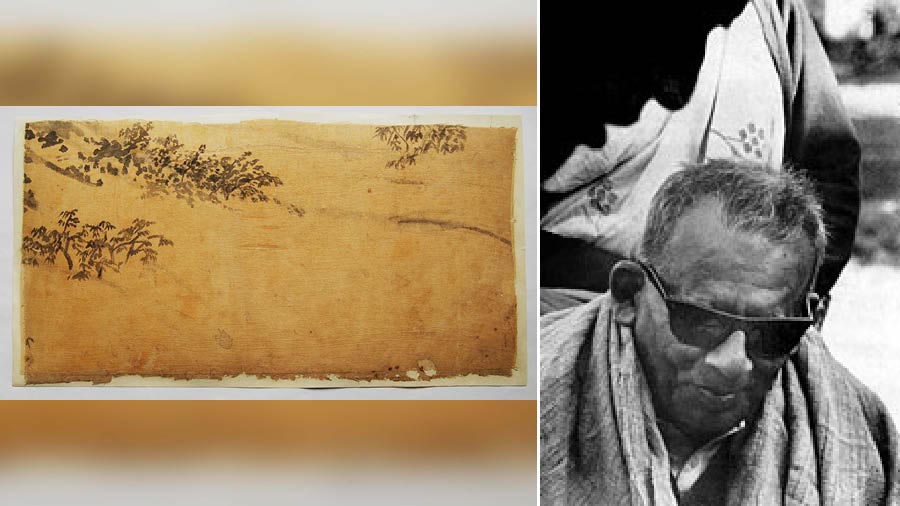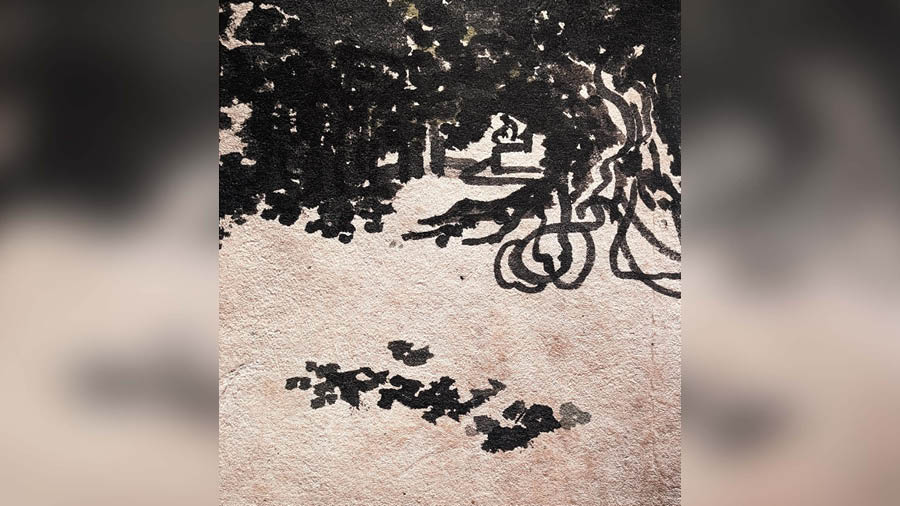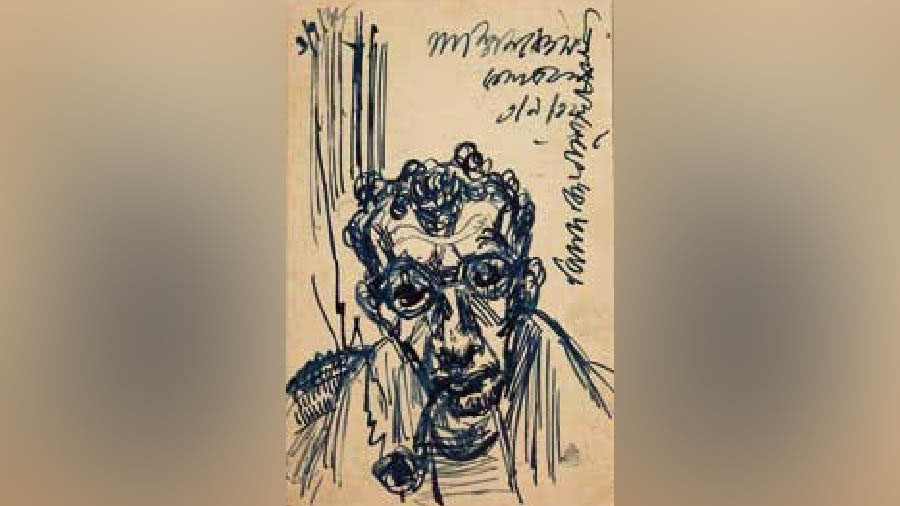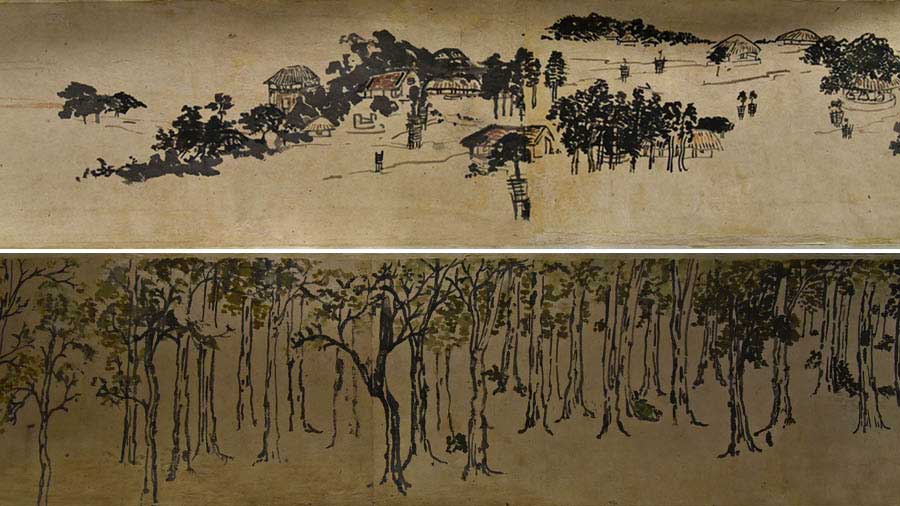It has been a journey without end for Scenes from Santiniketan & Benodebehari Mukherjee’s Handscrolls. This exhibition has a number of Santiniketan scapes in different formats that reveal the artist’s creative oeuvre. But at the heart of it — the hero of our story — is the 44.6-feet unique handscroll that began its expedition in Kolkata, for a month-long showcasing, moved to Santiniketan, which one viewed again at the Santiniketan Society of Visual Art and Design (SSVAD) and heard Professor R. Siva Kumar in an hour-long conversation with Sampurna Chakraborty at Arthshila. And it has culminated at the Durbar Hall in Ernakulum, Kochi, Kerala — from August 25 — to be there for a month, in association with the Kerala Lalithakala Akademi and in collaboration with Gallery Rasa of Kolkata to give a new set of viewers an exceptional lifetime experience.
Curated by the hugely respected art historian and art critic R. Siva Kumar, who has trawled the depths of Benodebehari’s psyche through his detailed study and the books on him, the unravelling of the scroll has been a source of historic import and visual impact for the thousands who have thronged the exposition.
First up, at the Kolkata Centre for Creativity. It was the last day of the show, and Rakesh Sahni of Gallery Rasa, who had serendipitously come by the handscrolls, gave me a full tour in the calmness of late morning, sans visitors. If it had not been for Sahni’s acquisition, about six years ago, the whole saga of the handscroll may never have got the traction it did. Apparently, the scroll changed hands a couple of times before its final appearance in the city.

The Kolkata exhibition, that was hosted by the Kolkata Centre for Creativity, in association with Gallery Rasa TT Archives
Professor Siva Kumar mentioned that he came upon the work when an art lover brought it to him for endorsement. Of particular interest is the fact that Benodebehari, in his early life, had actually sold off or even gifted his work to friends. But this particular scroll, he had handed over to artist Sudhir Khastagir who was Nandalal Bose’s student. Khastagir was to move to Dehradun as an art teacher, and there he is said to have gifted the scroll to another artist, from whom Rakesh Sahni acquired it.
The handscroll takes you on a mesmerising voyage, contained in a lit-up box at near chest height, where you start from the right, seeing the influences of the East Asian wash techniques unfold a naturescape that was native to Benodebehari. Yet through his infinite brilliance, he infused every date palm, the saal trees standing like sentries, the huts and animals, the Khoai, an often-austere landscape, with a dynamic narrative, where his invisible hand led you right up to the end, unlocking time and space and cocking a snook at the more static western canvases. The changing of the seasons also comes into play. As you start on discovering the various elements in the scroll, you should keep your eyes peeled for a tiny, solitary figure in the distance. Could it be the artist himself? In fact, we are led to believe that this is a recurrent motif in Japanese and Chinese scrolls where figures are strategically inserted to guide our viewing.

Another of the master’s scrolls
The way Professor Siva Kumar puts it: “As an artist with severe visual impairment and a painter of handscrolls, to Benodebehari mental registration and recollection were as essential as visual observation for pictorial representation. Thus, the thoughtful solitary figure at the head of this scroll, anticipating his self portrait as a reclusive artist in his studio from about ten years later, is an emblematic device that introduces us to his temperament and sets the mood of what is about to unravel.”
You could see he had not grouted himself in one place, but was influenced by the Japanese in his creative quest, particularly in his brushstrokes. This handscroll takes one back to the Santiniketan of the 1920s, as “viewed” by the partially sightless Benodebehari, for whom nature was his refuge and his outlet for artistic expression. Physical sightlessness surely made way for a larger vision. Satyajit Ray’s documentary The Inner Eye captures the essence of the artist like no other.
Here we must mention the Eastern infusion where the scroll paintings of East Asian countries, influenced Benodebehari. There was one in particular – a collotype copy of Japanese artist Sesshu Toyo’s Landscape and the Four Seasons, which inspired him. Sesshu was one of the greatest painters in Japanese history, a monk to boot, working in the 15th to 16th centuries. This particular piece came to India in 1916 and we learn from Professor Siva Kumar that Benodebehari liked the painting so much, he became fixated with wanting to do a long painting.

The details of one the handscrolls
And so, the handscrolls emerged, following the landscape of Santiniketan, communing with nature, making up for a lack of the physical seeing eye with a deeper insight.
Aaji hotey shoto barsho aagey, just a hundred years ago, Benodebehari Mukherjee came into this world as a visionary artist — who stood tall as a pioneering figure of eminence in the Indian Modernist movement. We see him in innumerable avatars — first as a student of the renowned Bengal School artist, Nandalal Bose, under whose guidance he honed his skills, particularly with regard to mural art, during his time at Rabindranath Tagore’s Santiniketan; later as a member of the teaching faculty; thence travels to distant places like Nepal as curator of a museum and teaching assignments in Rajasthan, finally coming back to roost at Kala Bhavan as its principal. More aspects — as a writer, his insightful autobiographical essays, compiled into the book Chitrakar, which includes his essay on aesthetics written from a personal point of view. The essays on other and on art education are collected in Chitrakatha.
Benodebehari’s artistic oeuvre was diverse — from watercolours, tempera on wood, works on silk, Chinese ink on paper to etchings and lithographs. And in the mid-1940s, came a magnificent mural which featured the medieval saint-poets of India, where his wife Leela collaborated with him.

A self portrait of the artist in pen and ink TT Archives
A most significant exhibition happened in 1997, which was to commemorate India’s half century of Independence. Professor Siva Kumar curated an exhibition titled Santiniketan: The Making of a Contextual Modernism. It proved to be a defining moment for modernism in Indian art. Through bringing to the fore a 100 works each not only of Benodebehari Mukherjee but also three other highly acclaimed modern Indian artists — Nandalal Bose, Rabindranath Tagore and Ramkinkar Baij. This exposition served to push the whole Santiniketan art movement to a different plane.
Contextually, I would like to mention how ‘Sivada’, as he is popularly known, is the expert on artists from Rabindranath Tagore (The Last Harvest); a landmark book in the Indian art scene, with a focus on Abanindranath Tagore; a two-volume book on Ramachandran; K.G.Subramanyan, ‘Manida’, whose work he has written extensively on and whose birth centenary comes up next year; Gaganendranath Tagore’s Satirical Pictures and so much more. Which gives us the confidence of gleaning and garnering true facts from a credible voice, one of sagacity and yet an individual whom I found so humble, but so lucid, so approachable. It was he brought out the fact, when I was in conversation with him at Arthshila in Santiniketan, about the fact of Benodebehari abjuring all nationalistic tendencies to concentrate on “reimagining Indian art ...by re-engaging with nature in the lonesome setting of Santiniketan.” Sivada also talked about how Tagore had dissociated himself from the Swadeshi movement so he could focus on “education, rural reconstruction and community building.”

The author with Professor R. Siva Kumar
In the Durbar Hall at Kochi, inaugurated by the mayor of the city, and attended by a galaxy of celebs from the world of art, and culture and politics, the visually guided talk titled ‘Landscape and the Artist’s Self: Benodebehari's Engagement with the Santiniketan Countryside’ by the curator of the exhibition was a huge draw, as were some of the fascinating exhibits like the square backlit mural which people viewed sitting down, or even in lying position, the scene in a jungle on banana pith which is in the collection of the V&A; several drawings, pages from his Chinese sketchbook and a lot more.
They are all reproductions, except for the dramatic handscroll, which is an original, and has been pasted on Japanese paper to give it strength, is carried around by Gallery Rasa’s Rakesh Sahni in a 12-inch container and further put into a steel box with locks which is then hand carried for complete security! So that it can travel to newer venues like Delhi, Mumbai, Goa, and who knows beyond Indian shores.
Its journey is truly unending, for this masterpiece needs sharing and viewing and ingesting.

